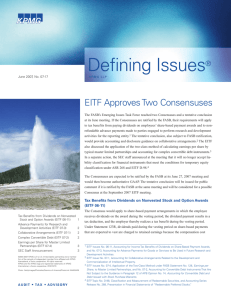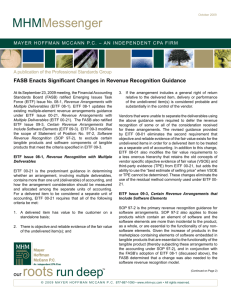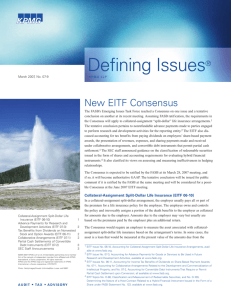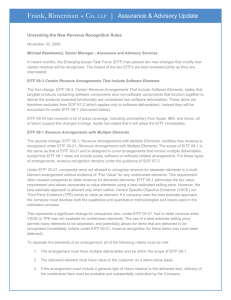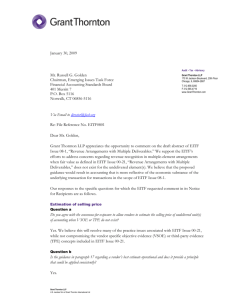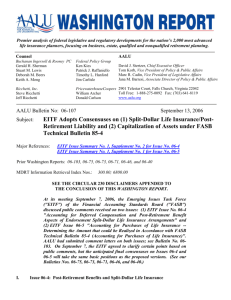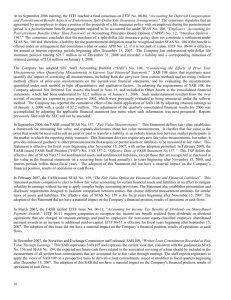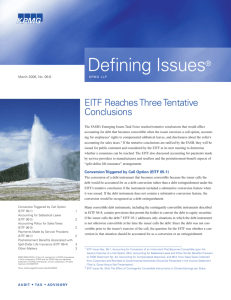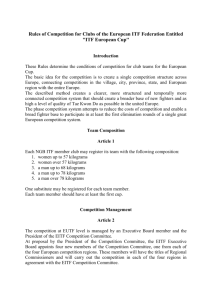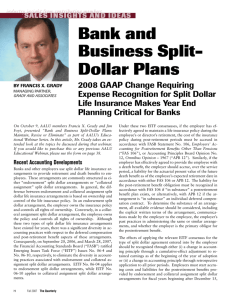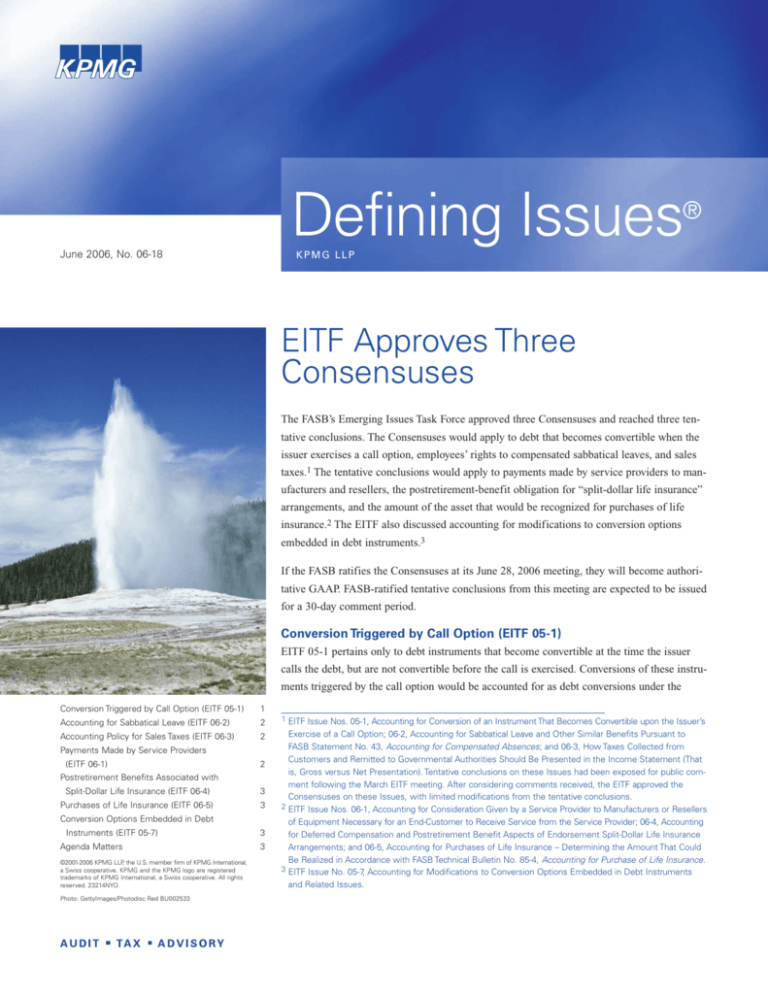
Defining Issues
®
June 2006, No. 06-18
KPMG LLP
EITF Approves Three
Consensuses
The FASB’s Emerging Issues Task Force approved three Consensuses and reached three tentative conclusions. The Consensuses would apply to debt that becomes convertible when the
issuer exercises a call option, employees’ rights to compensated sabbatical leaves, and sales
taxes.1 The tentative conclusions would apply to payments made by service providers to manufacturers and resellers, the postretirement-benefit obligation for “split-dollar life insurance”
arrangements, and the amount of the asset that would be recognized for purchases of life
insurance.2 The EITF also discussed accounting for modifications to conversion options
embedded in debt instruments.3
If the FASB ratifies the Consensuses at its June 28, 2006 meeting, they will become authoritative GAAP. FASB-ratified tentative conclusions from this meeting are expected to be issued
for a 30-day comment period.
Conversion Triggered by Call Option (EITF 05-1)
EITF 05-1 pertains only to debt instruments that become convertible at the time the issuer
calls the debt, but are not convertible before the call is exercised. Conversions of these instruments triggered by the call option would be accounted for as debt conversions under the
Conversion Triggered by Call Option (EITF 05-1)
1
Accounting for Sabbatical Leave (EITF 06-2)
2
1 EITF Issue Nos. 05-1, Accounting for Conversion of an Instrument That Becomes Convertible upon the Issuer’s
Accounting Policy for Sales Taxes (EITF 06-3)
2
Exercise of a Call Option; 06-2, Accounting for Sabbatical Leave and Other Similar Benefits Pursuant to
FASB Statement No. 43, Accounting for Compensated Absences; and 06-3, How Taxes Collected from
Customers and Remitted to Governmental Authorities Should Be Presented in the Income Statement (That
is, Gross versus Net Presentation). Tentative conclusions on these Issues had been exposed for public comment following the March EITF meeting. After considering comments received, the EITF approved the
Consensuses on these Issues, with limited modifications from the tentative conclusions.
2 EITF Issue Nos. 06-1, Accounting for Consideration Given by a Service Provider to Manufacturers or Resellers
of Equipment Necessary for an End-Customer to Receive Service from the Service Provider; 06-4, Accounting
for Deferred Compensation and Postretirement Benefit Aspects of Endorsement Split-Dollar Life Insurance
Arrangements; and 06-5, Accounting for Purchases of Life Insurance – Determining the Amount That Could
Be Realized in Accordance with FASB Technical Bulletin No. 85-4, Accounting for Purchase of Life Insurance.
3 EITF Issue No. 05-7, Accounting for Modifications to Conversion Options Embedded in Debt Instruments
and Related Issues.
Payments Made by Service Providers
(EITF 06-1)
2
Postretirement Benefits Associated with
Split-Dollar Life Insurance (EITF 06-4)
3
Purchases of Life Insurance (EITF 06-5)
3
Conversion Options Embedded in Debt
Instruments (EITF 05-7)
Agenda Matters
©2001-2006 KPMG LLP, the U.S. member firm of KPMG International,
a Swiss cooperative. KPMG and the KPMG logo are registered
trademarks of KPMG International, a Swiss cooperative. All rights
reserved. 23214NYO
Photo: GettyImages/Photodisc Red BU002533
3
3
Defining Issues June 2006, No. 06-18 2
Consensus if the instrument included a sub-
ment in which the employee is not required
application to all prior periods would also be
stantive conversion feature other than the call
to perform any duties during the absence,
permitted. If ratified, the Consensus will be
option when it was issued. The conversions
“accumulates” and therefore should be
effective for fiscal years beginning after
would be recognized as debt extinguishments
accounted for as a liability if the other con-
December 15, 2006 with early application
if the debt instrument did not contain a sub-
ditions for recognition in Statement 43 are
permitted, provided the entity has not issued
stantive conversion feature at issuance.
met.5 The other conditions in Statement 43
any financial statements for any period of
are that the obligation relates to services
the earlier fiscal year.
Companies would determine whether a debt
already rendered, payment is probable, and
the amount can be reasonably estimated.
Accounting Policy for Sales Taxes
(EITF 06-3)
However, the determination need not be
For example, an employee is eligible to take
Consensus 06-3 would permit companies to
made when the instrument is issued. For pur-
ten weeks of sabbatical leave after eight years
elect to present on either a gross or net basis
poses of the Consensus, the instrument’s
of service. The employee continues to be
sales and other taxes that are imposed on and
issuance date would be the same as its com-
compensated during the sabbatical, but is not
concurrent with individual revenue-producing
mitment date as defined in EITF 00-27.4
required to perform any duties. The right to
transactions between a seller and a customer.
the compensated absence does not vest,
The gross basis includes the taxes in revenues
because the employee is not entitled to pay-
and costs; the net basis excludes the taxes
ment for unused sabbatical when employ-
from revenues. The Consensus would not
ment terminates. However, the employer’s
apply to tax systems that are based on gross
obligation for the sabbatical “accumulates,”
receipts or total revenues.
instrument has a substantive conversion feature as of the instrument’s issuance date.
A debt instrument’s conversion feature is
substantive, according to the Consensus, if it
is “reasonably possible” that it will be exercised without being triggered by the issuer
calling the debt. A conversion feature that
can be exercised only if the issuer calls the
debt would not be a substantive conversion
feature.
The published Consensus will contain examples of methods to determine whether a conversion feature is substantive.
and therefore, assuming the other conditions
of Statement 43 are met, the compensation
cost for the sabbatical should be recognized
as a liability over the required eight-year
service period.
Sabbatical leave arrangements that obligate
the employee to perform research or otherwise
Companies would disclose their policy for
presenting the taxes and would disclose any
amounts presented on a gross basis.
Companies would not be required by the
Consensus to change their policies for presenting taxes. A change would be permitted
only if the new policy is considered preferable.
The Consensus will be effective for conver-
benefit the employer during the sabbatical
sions that occur as a result of the issuer’s
period are excluded from the scope of this
Assuming ratification, the disclosures
exercise of a call option in interim or annual
Consensus. The Consensus also does not
required by the Consensus will have to be
periods beginning after the date of FASB rat-
address how to measure the liability.
presented for interim and annual financial
ification.
A liability for sabbatical leaves recorded in
periods beginning after December 15, 2006.
Accounting for Sabbatical Leave
(EITF 06-2)
accordance with this Consensus would be
recognized as a change in accounting princi-
Payments Made by Service
Providers (EITF 06-1)
The EITF reached a Consensus that an
ple through a cumulative-effect adjustment
The EITF reached a tentative conclusion on
employee’s right to a compensated absence
to retained earnings as of the beginning of
accounting for payments of cash and other
under a sabbatical or similar benefit arrange-
the year of adoption. However, retrospective
consideration by providers of services that
4 EITF Issue No. 00-27, Application of Issue No. 98-5 to Certain Convertible Instruments.
5 FASB Statement No. 43, Accounting for Compensated Absences, November 1980, available at
www.fasb.org.
©2001-2006 KPMG LLP, the U.S. member firm of KPMG International, a Swiss cooperative. All rights reserved. 23214NYO
Defining Issues June 2006, No. 06-18 3
depend on specialized equipment to the
accounting principle through retrospective
would be realized only by surrendering all of
manufacturers or resellers of the specialized
application to all prior periods.
the policies or certificates would not be
equipment. TV, radio, and security services
are among those that might depend on specialized equipment. The payments could be
incentives to reduce the selling price of the
equipment in order to stimulate end-customer
demand for the services. The payments could
be in the form of cash, equity instruments,
tooling, technological know-how, or key
components of the specialized equipment.
The Task Force tentatively concluded that a
service provider should characterize the consideration based on the form of the benefit
the service provider’s customer receives from
the manufacturer or reseller. If the benefit
provided by the manufacturer or reseller to
the service provider’s customer is other than
cash (such as a discount on the price of the
equipment) or the service provider does not
control the form of benefit given by the
manufacturer or reseller to the end-customer,
the consideration the service provider gives
the manufacturer or reseller would not be
Postretirement Benefits
Associated with Split-Dollar Life
Insurance (EITF 06-4)
included when measuring the assets.
The tentative conclusion would be effective
for periods beginning after December 15,
The EITF tentatively concluded that the
2006, and would be applied by recognizing a
deferred-compensation or postretirement
cumulative-effect adjustment at the date of
benefit aspects of an endorsement-type split-
adoption for all life insurance contracts cur-
dollar life insurance arrangement should be
rently held. Alternatively, retrospective appli-
recognized as a liability by the employer and
cation would be permitted.
that the obligation is not effectively settled
by the purchase of a life insurance policy.
Conversion Options Embedded in
Debt Instruments (EITF 05-7)
If adopted as a ratified Consensus, this ten-
The EITF considered accounting for modifi-
tative conclusion could significantly change
cations to conversion options embedded in
some companies’ current practices. The ten-
debt instruments that are not required to be
tative conclusion would be effective for fiscal
bifurcated from the host contract and
years beginning after December 15, 2006.
accounted for at fair value under Statement
The effect of initially applying the guidance
133.7 The Task Force revisited the existing
would be accounted for in a manner similar
Consensuses on EITF 05-7 and discussed
to a cumulative-effect-type adjustment.
how a change in terms should be evaluated
Alternatively, companies would be permitted
to determine whether a debt instrument has
to apply the Consensus retrospectively to all
been extinguished. It also discussed whether
prior periods.
evaluating the significance of a change in
the terms of a conversion option should be
service provider’s customer receives cash as
Purchases of Life Insurance (EITF
06-5)
directed by the service provider, the consid-
The EITF tentatively concluded that a poli-
eration given by the service provider to the
cyholder should consider any additional
manufacturer or reseller would be presented by
amounts included in the contractual terms of
The existing Consensuses on EITF 05-7 con-
the service provider as a reduction of revenue.
the life insurance policy in determining the
tinue to apply until any changes are made by
“amount that could be realized under the
the EITF.
presented as a reduction in revenue. If the
separate from analyzing whether a modification has occurred as required under EITF
96-19.8
The potential Consensus would be effective
insurance contract.”6 For group policies with
for the first annual reporting period begin-
multiple certificates or multiple policies with
Agenda Matters
ning after June 15, 2007. Early adoption
a group rider, the Task Force also tentatively
The Task Force removed EITF 04-7, on iden-
would be permitted as of the beginning of
concluded that the amount that could be real-
tifying a variable interest in a potential variable-
the company’s fiscal year. Applying the
ized should be determined on the individual-
interest entity, from its agenda, because that
guidance would be treated as a change in
policy or certificate level. Amounts that
issue has been addressed by FASB Staff
6 FASB Technical Bulletin No. 85-4, Accounting for Purchases of Life Insurance, available at www.fasb.org.
7 FASB Statement No. 133, Accounting for Derivative Instruments and Hedging Activities, June 1998, avail-
able at www.fasb.org.
8 EITF Issue No. 96-19, Debtor’s Accounting for a Modification or Exchange of Debt Instruments.
©2001-2006 KPMG LLP, the U.S. member firm of KPMG International, a Swiss cooperative. All rights reserved. 23214NYO
Position FIN 46(R)-6.9 The Task Force added to its agenda EITF 06-E, on previously-bifurcated conversion options in convertible debt that no longer meet the bifurcation criteria in
paragraph 12 of Statement 133.10
Ú
Ú
Ú
The Task Force is expected to consider public comments on the tentative conclusions
described above at the September 6-7, 2006 EITF meeting and to determine whether to
approve them as final Consensuses.
The descriptive and summary statements above are not intended to be a substitute for the
texts of the EITF’s Consensuses, tentative conclusions, or official minutes or any other
potential or actual requirements. In determining the appropriate accounting treatment for a
transaction, companies should refer to the texts of the applicable documents that set out
requirements, including the formal EITF meeting minutes that will be made available on the
FASB Web site, consider the specific circumstances, and consult their accounting and legal
advisors.
This is a publication of KPMG’s
Department of Professional
Practice—Audit
212-909-5600
Contributing authors:
Mark M. Bielstein
Landon B. Westerlund
Robert B. Malhotra
Adam L. Wieder
Earlier editions are available at:
www.aro.kpmg.com
Defining Issues® is a registered trademark of KPMG LLP. © 20012006 KPMG LLP, the U.S. member firm of KPMG International, a
Swiss cooperative. KPMG and the KPMG logo are registered trademarks of KPMG International, a Swiss cooperative. All rights
reserved. A23214NYO
9 EITF Issue No. 04-7, Determining Whether an Interest is a Variable Interest in a Potential Variable Interest
Entity; FASB Staff Position FIN 46(R)-6, Determining the Variability to Be Considered in Applying FASB
Interpretation No. 46(R), available at www.fasb.org.
10 EITF Issue No. 06-E, Accounting for a Previously-Bifurcated Conversion Option in Convertible Debt That No
Longer Meets the Bifurcation Criteria in Paragraph 12 of FASB Statement No. 133, “Accounting for Derivative
Investments and Hedging Activities.”

